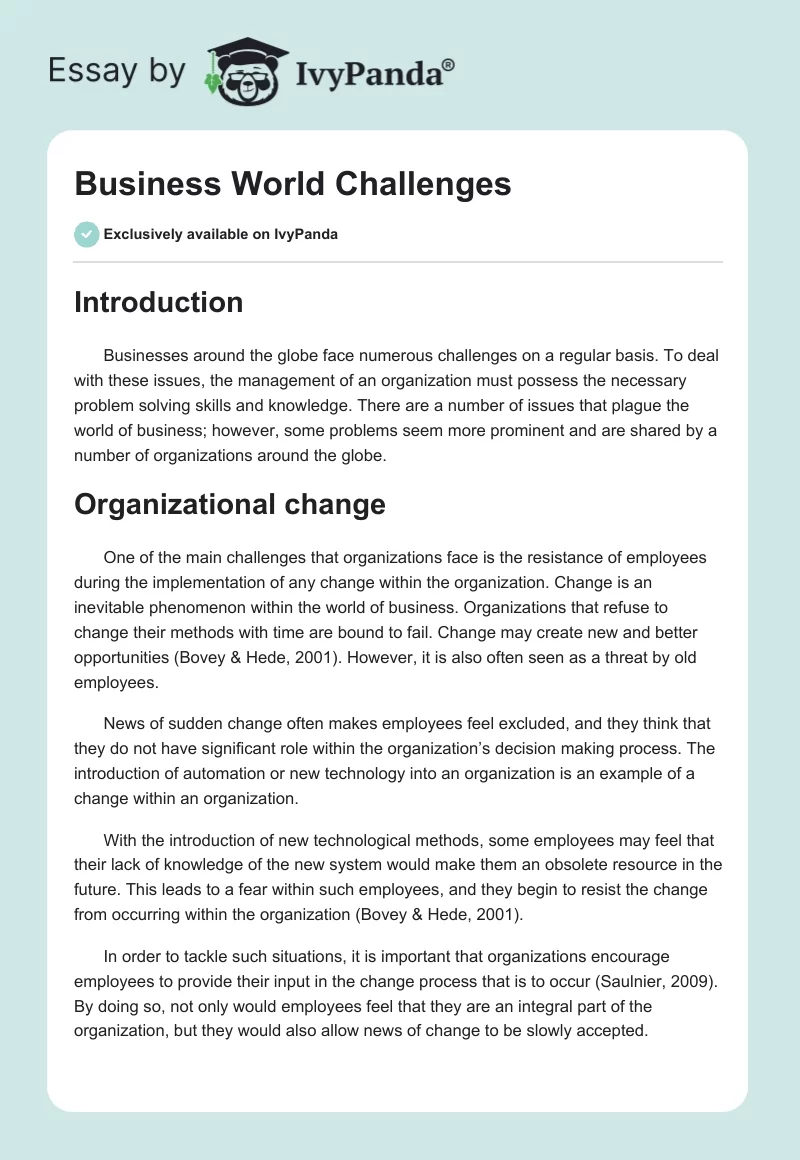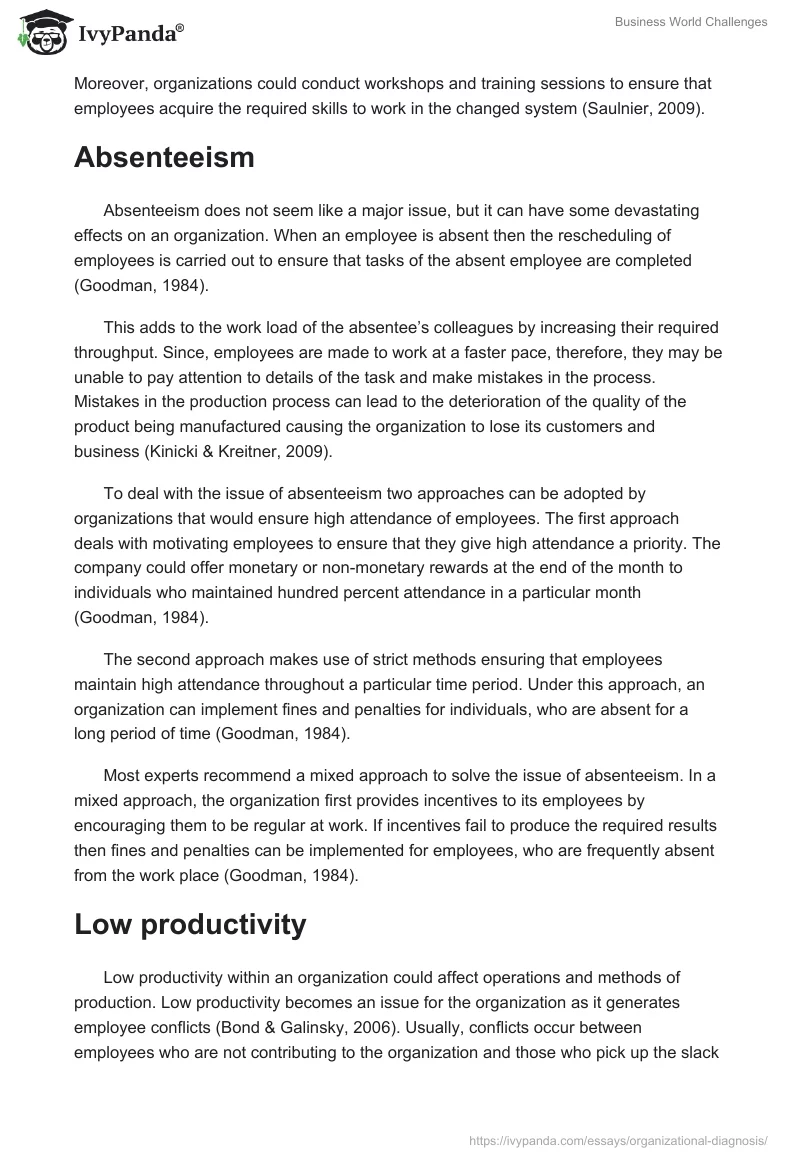Introduction
Businesses around the globe face numerous challenges on a regular basis. To deal with these issues, the management of an organization must possess the necessary problem solving skills and knowledge. There are a number of issues that plague the world of business; however, some problems seem more prominent and are shared by a number of organizations around the globe.
Organizational change
One of the main challenges that organizations face is the resistance of employees during the implementation of any change within the organization. Change is an inevitable phenomenon within the world of business. Organizations that refuse to change their methods with time are bound to fail. Change may create new and better opportunities (Bovey & Hede, 2001). However, it is also often seen as a threat by old employees.
News of sudden change often makes employees feel excluded, and they think that they do not have significant role within the organization’s decision making process. The introduction of automation or new technology into an organization is an example of a change within an organization.
With the introduction of new technological methods, some employees may feel that their lack of knowledge of the new system would make them an obsolete resource in the future. This leads to a fear within such employees, and they begin to resist the change from occurring within the organization (Bovey & Hede, 2001).
In order to tackle such situations, it is important that organizations encourage employees to provide their input in the change process that is to occur (Saulnier, 2009). By doing so, not only would employees feel that they are an integral part of the organization, but they would also allow news of change to be slowly accepted. Moreover, organizations could conduct workshops and training sessions to ensure that employees acquire the required skills to work in the changed system (Saulnier, 2009).
Absenteeism
Absenteeism does not seem like a major issue, but it can have some devastating effects on an organization. When an employee is absent then the rescheduling of employees is carried out to ensure that tasks of the absent employee are completed (Goodman, 1984).
This adds to the work load of the absentee’s colleagues by increasing their required throughput. Since, employees are made to work at a faster pace, therefore, they may be unable to pay attention to details of the task and make mistakes in the process. Mistakes in the production process can lead to the deterioration of the quality of the product being manufactured causing the organization to lose its customers and business (Kinicki & Kreitner, 2009).
To deal with the issue of absenteeism two approaches can be adopted by organizations that would ensure high attendance of employees. The first approach deals with motivating employees to ensure that they give high attendance a priority. The company could offer monetary or non-monetary rewards at the end of the month to individuals who maintained hundred percent attendance in a particular month (Goodman, 1984).
The second approach makes use of strict methods ensuring that employees maintain high attendance throughout a particular time period. Under this approach, an organization can implement fines and penalties for individuals, who are absent for a long period of time (Goodman, 1984).
Most experts recommend a mixed approach to solve the issue of absenteeism. In a mixed approach, the organization first provides incentives to its employees by encouraging them to be regular at work. If incentives fail to produce the required results then fines and penalties can be implemented for employees, who are frequently absent from the work place (Goodman, 1984).
Low productivity
Low productivity within an organization could affect operations and methods of production. Low productivity becomes an issue for the organization as it generates employee conflicts (Bond & Galinsky, 2006). Usually, conflicts occur between employees who are not contributing to the organization and those who pick up the slack for them. Both types start blaming each other for mistakes being made, which results in delays in the organization.
The major reason for low productivity is usually associated with the lack of coordination between the management, departments, and colleagues (Bond & Galinsky, 2006). Coordination is an essential process of any business. Without coordination, mismanagement is a normal sight in an organization. Mismanagement tends to lead to mistakes, which eventually result in dissatisfied customers and loss of business (Kinicki & Kreitner, 2009).
One solution that can improve productivity in an organization is the segmentation of tasks between various departments and individuals (Bond & Galinsky, 2006). By segmentation of tasks and activities, each employee would know his or her role within the organization. Moreover, in case of a mistake within the manufacturing of a product, the management would be able to pin point individuals responsible for the mistake (Bond & Galinsky, 2006).
This eliminates arguments between employees caused by mistakes or delays made in the manufacturing process of a product. Assigning tasks increases an individual’s responsibility, which in turn improves the overall productivity of the organization (Bond & Galinsky, 2006).
Reference List
Bond, J. T., & Galinsky, E. (2006). How can employers increase the productivity and retention of entry-level, hourly employees? New York, US: Families and Work institutes.
Bovey, W. H., & Hede, A. (2001). Resistance to organizational change: the role of cognitive and affective processes. Leadership and organization development Journal, 22(8), 372-382.
Goodman, P. S. (1984). Effects of absenteeism on individuals and organization. Pittsburgh: Tepper School of Business.
Kinicki, A., & Kreitner, R. (2009). Organizational Behavior. New York: McGraw Hill.
Saulnier, D. (2009). Organizational effectiveness preparing your workforce for change. Melbourne: Right Management.


